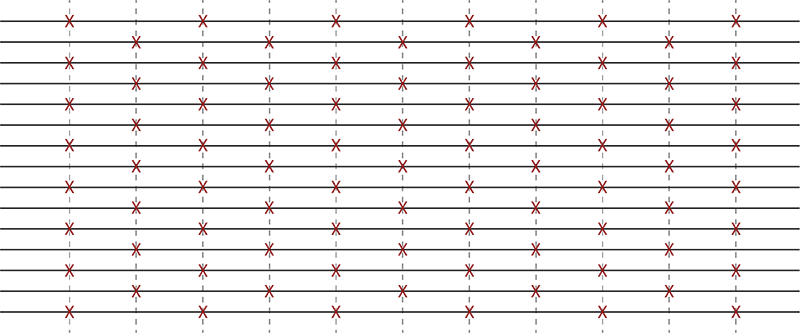Project Details
I have been in serious need of a workbench for my projects. My two sawhorses and piece of plywood just aren’t cutting it. I was gifted a great set of old desks that were found for $25 each on Facebook Marketplace. The tops were in great shape, but the bottoms left a lot to be desired.
However, there are a lot of materials to be had with these two desks, and I wanted to make something that would fit for my space now and allow me to grow/add to it over time.
Part 1 of this project is the tabletop. I wanted to salvage as much as I could from the existing wood. Both tops are in very good condition, each made of 16 or 17 continuous pieces of well-maintained, flat boards. They were glued together at one point but have since popped apart. The aesthetic is similar to butcher block, but instead of several, different length pieces glued together, they are all the same length. I’m not certain what kind of glue was first used to assemble these boards, but it didn’t leave any residue when separating them. Good for cleaning it to reassemble, but bad for longevity.
Each set of wood top pieces came numbered, but I would suggest a similar process to identify order and orientation if starting with new boards. You can also draw a triangle on the pieces so you can keep track, but I’m better with simple number/letter combos.
First, I laid out the pieces in order on a large surface and clamped them together, taking care to align the ends. Next, I needed to measure the location of each biscuit. Biscuits are oblong wooden discs that sit between two facing pieces of wood. A biscuit joiner cuts out a slit of wood from the center to make space for the biscuit. After you have cut matching biscuit holes in the facing boards, the biscuit is inserted during glue up to assure that the pieces are aligned evenly down the length of the boards. Since this is a large 60-inch span, I needed to make sure the glue up was as close to flush as possible.
At first, I put in WAY too many biscuits. Too many makes it difficult to seat them during glue up, because you have to align a lot of biscuits with holes. After the first couple of boards, I chose to put them every 10 or so inches. That seemed to be more reasonable.
The boards have biscuits on both sides, so I staggered the holes to assure they wouldn’t overlap in the middle. Using a long straight edge, I marked lines across all the boards every 5 inches (but not within 6 inches of either end) to map where the biscuits should be placed, and then I marked every other intersecting line (10 inches apart) with large dots on each board where I would cut the biscuit hole. Take time getting the alignment right, so you don’t have to question what you were thinking when you marked it. Trust your dots.
The setup would look something like this:

After you have set up your cut marks, it’s time to get to biscuiting. I used #20 sized biscuits. Biscuit joiners are all different, so follow your manufacturer’s guide to setting it up to get the perfect cut. I suggest using a scrap piece of board to align your cuts prior to plunging into your actual boards. Since my materials were reclaimed, I cut a piece of scrap wood to the same depth and tested my joiner location.
Biscuit holes are cut. Now it’s time to glue everything up. I chose to glue up my top in 2 sections and then attach the larger sections later. You can do it all at once. It’s only a preference. Apply glue evenly to both faces of the wood, making sure to get some into the biscuit slot. Insert biscuits into each hole and align the pieces. I used a 16 oz rubber mallet to persuade the pieces together. For each half of the top, I set the piece on its side and had gravity help me a bit with setting the biscuits.
I tried my clamping approach a couple of ways, and the most successful was to elevate the top on 4x4s to support both ends and the middle. Using 4 pipe clamps, I alternated my clamps above and below the piece. To ensure the ends were close to flush, I clamped a straight piece of wood to either end. Since I was using wooden straight pieces and I didn’t want to glue my clamps to the top, I put down wax paper over the glued piece for easy unclamping.
Let’s talk about glue clean up. First, you want some glue to squeeze out. That is a visual cue that your boards are touching and you’ve applied enough adhesive. Some people sit firmly in the “clean up before it dries” camp and others like to wait until it’s dry to sand or plane it off. I have no preference, but I did find that wiping it off didn’t impact how much I had to plane the piece. If my piece were closer to finished and it was a final glue-up with no additional planing or significant sanding, I would probably wipe it off with a damp rag. However, for this project, I preferred just letting it dry and coming after it with a planer and sander later.
I allowed each of my glued and clamped pieces to cure for at least 24 hours. Then, I planed the top down by hand to have a mostly even face. This took a long time. If you have a nice planer machine, I would definitely suggest using it. Make sure your glued pieces are within the width your machine will take and send them through at the same time. But, man alive, hand planing was a workout.
And my planing wasn’t great. I had gouge marks and it’s not exactly even, but it’s a work table. I’m sure I’ll have those things later anyway.
After planing, I went over the surface with 80-, 150-, and 220-grit sandpaper to get it to a nice smooth surface. My ends weren’t quite even, so I marked a straight edge and clamped a board at the line to run my circular saw against to ensure a straight cut. A few cuts later, and the top is complete.
I’ve got a great plan for the base to these tops. I’ll have more on that as soon as we can all stop social distancing ourselves with this COVID-19 thing.
Stay well, and get in the shop!
